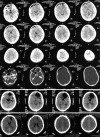Outcome of Posttraumatic Delayed Intracerebral Tension Pneumatocele: Prospective Study of Four Cases: Single Institutional Experience
- PMID: 30459874
- PMCID: PMC6208253
- DOI: 10.4103/ajns.AJNS_226_17
Outcome of Posttraumatic Delayed Intracerebral Tension Pneumatocele: Prospective Study of Four Cases: Single Institutional Experience
Abstract
Aim: Delayed intracerebral tension pneumatocele (DITP) is an uncommon cause of raised intracranial pressure following trauma. However, it can cause herniation syndrome due to a sudden increase in intracranial pressure which requires emergent intervention. Pneumocephalus is a complication of head injury in 3.9%-9.7% of the cases. The accumulation of intracranial air can be acute (<72 h) or delayed (≥72 h).
Method: When intracranial air causes intracranial hypertension and has a mass effect with neurological deterioration, it is called tension pneumocephalus. In our case series, we demonstrated four cases of DITP in adult patients from January 2012 to January 2017 in the Department of Neurosurgery at R. N. T. Medical College and M. B. Hospital, Udaipur, Rajasthan.
Result: During this period, a total number of patients admitted of head injury are 1768 and hence, the incidence of DITP in our series is 0.226% which is very less as compared to previous literature. All patients are male; age ranging from 17 years to 55 years (mean age was 31.75 years). All patients have a history of head injury, and mode of injury had road traffic accidents. Glasgow Coma Score (GCS) at readmission were 12-13 (mean GCS 12.75). Duration of developed DITP 1 month to 2½ months (mean 1.375 months), all patients had gone to surgical intervention, and outcome assessed using Glasgow outcome score. All patients had a good outcome and average follow-up was 12.5 months.
Conclusion: long term observation of patients with simple pneumocephalus following trauma is beneficial as there is an expected risk of developing delayed tension pneumocephalus which may manifest with raised intracranial pressure.
Keywords: Cerebrospinal fluid rhinorrhea; intracerebral; pneumocephalus; tension pneumatocele.
Conflict of interest statement
There are no conflicts of interest.
Figures




References
-
- Markham JW. The clinical features of pneumocephalus based upon a survey of 284 cases with report of 11 additional cases. Acta Neurochir (Wien) 1967;16:1–78. - PubMed
-
- Nazir SS, Wani MA, Kirmani AR. Post- traumatic subdural with intraventricular pneumatocele: A case report and review of literature. JK Pract. 2004;11:50–3.
-
- Huang CF, Chou TY, Chang CK. Traumatic tension pneumocephalus – Intracerebral pneumatocele: A case report. Gaoxiong Yi Xue Ke Xue Za Zhi. 1992;8:113–6. - PubMed
-
- Schirmer CM, Heilman CB, Bhardwaj A. Pneumocephalus: Case illustrations and review. Neurocrit Care. 2010;13:152–8. - PubMed
-
- Oge K, Akpinar G, Bertan V. Traumatic subdural pneumocephalus causing rise in intracranial pressure in the early phase of head trauma: Report of two cases. Acta Neurochir (Wien) 1998;140:655–8. - PubMed

